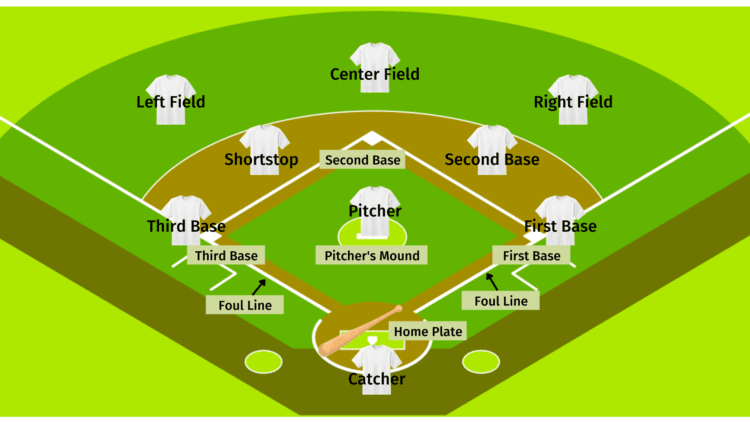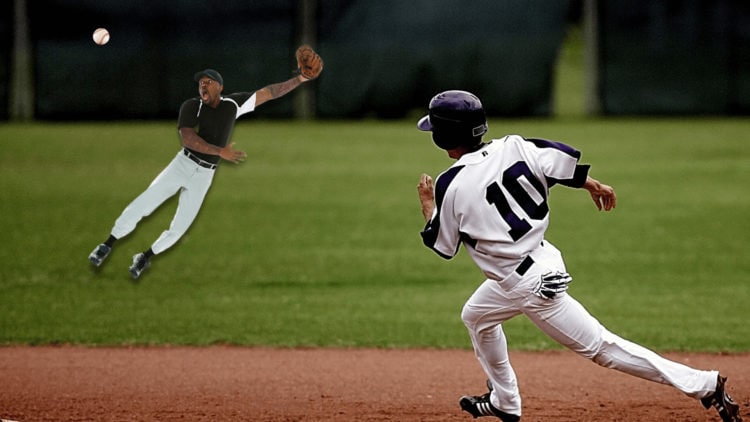
OBJECTIVE OF BASEBALL: Score more runs than the other team over 9 innings.
NUMBER OF PLAYERS: 18 players, 9 on each team
MATERIALS: 1 baseball, at least 1 baseball bat, 1 glove per fielder
TYPE OF GAME: Sport
AUDIENCE: 7+
OVERVIEW OF BASEBALL

Baseball was the USA’s first organized sport, with the first professional league starting in the mid-19th century. Baseball has been around for a long time and is still a widely loved sport in the USA and abroad. Whether you are batting, pitching, or catching the ball, you’ll need some serious hand-eye coordination to play baseball.
SETUP

Field
Baseball is played on a diamond-shaped field that is about 400 feet long, separated by the infield and outfield. The outfield is a grassy area while the infield is sand. There are four bases surrounding the infield with about 90 feet between each base: first base, second base, third base, and home plate. There is a small hill in the middle of the infield called the pitcher’s mound. The outfield boundary is marked with a fence or wall.
2 lines stretch out from either side of the home plate, creating a large right angle. These are called the foul lines and determine whether a ball is a foul or a fair ball. There is also a small rectangle on either side of the home plate called the batter’s box.
Players
There are 9 defensive players on the field at one time. Here is a list of the defensive positions:
- Pitcher – Throws the ball into play from the pitcher’s mound towards home plate.
- Catcher – Kneels behind home plate and catches the ball that the pitcher throws.
- First baseman – Stands near first base, prepared to catch the ball and force the baserunner out.
- Second baseman – Stands between second base and first base, prepared to catch infield balls, throw to other basemen, and force or tag baserunners out at the second base.
- Third baseman – Stands near third base, prepared to catch infield balls, throw to other basemen, and tag or force baserunners out at the third base.
- Shortstop – Stands between second base and the third baseman, prepared to catch infield balls and quickly throw to other basemen to force baserunners out.
- Centerfielder – Stands in the center of the outfield prepared to catch fly balls, or retrieve balls and throw them to the infield.
- Right Fielder – Stands on the right side of the outfield and prepares to catch fly balls, or retrieve balls and throw them to the infield.
- Left Fielder – Stands on the left side of the outfield and prepares to catch fly balls, or retrieve balls and throw them to the infield.
The offensive team in baseball sends 1 batter at a time to home plate. The batter tries to make it to first base by:
- Hitting the ball and running to first base before the first baseman catches the ball and stands on first base.
- “Walking” by being thrown 4 bad pitches (or balls).
GAMEPLAY

A baseball game is played in 9 innings. 1 inning has 2 halves called the “top” and the “bottom”. Each team gets 3 outs per inning to try and score as many runs as possible.
Game Start
A baseball game is played at the home stadium of one of the competing teams. The “home” team always allows the “away” team to bat in the top of the first inning. The game starts with the home team playing defense and the “away” team batting.
Strikes and Balls
A batter is allowed 3 strikes before they are called “out”, and if the team gets 3 “outs”, their half of the inning ends and the other team gets to bat.
Strike Zone
When the pitcher throws the ball, it is either a “strike” or a “ball”. The pitch is called a strike if the ball lands in the strike zone and the batter either swings and misses or doesn’t swing at all.
The strike zone is best described as a rectangular invisible box located just over the home plate that stretches from the batter’s shoulders to their knees.
If the ball lands outside of this box and the batter doesn’t swing, the umpire calls a “ball”. The only case in which a “ball” is called a strike is when the batter swings at a ball and misses.
Foul Balls
If a batter hits a pitch and it lands outside of either of the foul lines, the ball is a foul ball. A foul ball gives the batter a strike unless the batter already has 2 strikes because a batter cannot be called out on a foul ball.
Walks
If a pitcher throws 4 pitches that are outside of the strike zone and the umpire calls them “balls”, the batter automatically advances to first base.
Baserunning
When a batter hits a ball that is inside the foul lines, they must advance to first base or further, if possible. If there is a runner on first base, they must advance to second base, and if there is a runner on third base, they must advance to third base.
At first base, the runner can run through the base along the foul line and still be considered “safe”. However, at second and third base, a runner can be called out if they run past the base and the baseman stands on the base with the ball in their glove or tags them.
Scoring
A run is scored when a baserunner makes it all of the way around the bases and touches home plate without being called out. A run is also scored automatically when a player hits a home run. A home run is when the ball is hit over the outfield boundary. When this happens, the hitter and every baserunner run around the bases and score.
Outs
Here are all of the ways to be called out in baseball.
Tagging Out
If a baserunner slides or runs towards second base, third base, or home plate, and the baseman tags them with the ball in their glove before the baserunner touches the base, the baserunner is out.
Forcing Out
The baseman doesn’t have to tag the baserunner if they are forced to advance to the next base. For example, if a runner is on first base and the batter hits a ball into play, the runner must advance to second base. All the second baseman has to do to get the runner out is stand on second base with the ball in their glove.
Striking Out
If a batter swings and misses 3 times or fails to swing at 3 strikes, they will be out.
Fly Balls
If a player hits a ball into play and a defensive player catches the ball before it hits the ground the batter is automatically out. When a fly ball is caught by a fielder, none of the baserunners are allowed to advance until after the ball has been caught.
END OF GAME
A baseball game ends at the bottom of the ninth innings with the home team at-bat. The game ends at the top of the ninth inning if the home team is in the lead.
If the game is tied after the bottom of the ninth, the game goes into extra innings. Both teams get another chance to score more than the opposing team until one team comes out on top.
If you enjoyed the rules for Baseball, checkout our rules for Softball!
- 30 GAMES TO PLAY OVER TEXT - April 22, 2024
- 20+ FREE PRINTABLE BABY SHOWER GAMES - April 16, 2024
- 20+ College Party Games for the Best Night Ever! - April 2, 2024